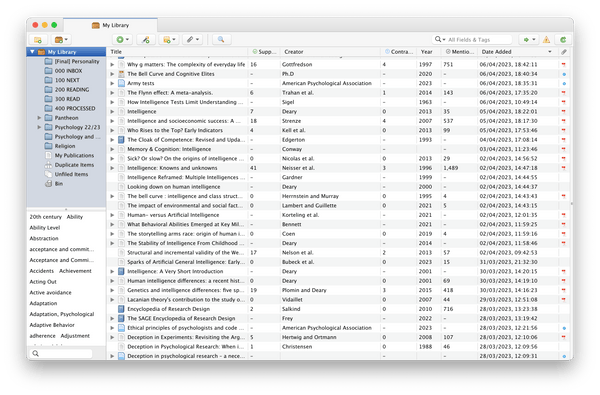I failed out of high school.
Last year I received an academic achievement award—here's the proof.
Almost every essay I have written has been awarded at least 70% (Lower First Class Honours, or a 4.0 GPA).
This is not because I am smart. If you want smart, listen to Balaji Srinivasan talk for more than 90 seconds. That is smart.
Regardless of being a bit of an idiot, I have managed consistently achieve good grades because I follow a system that addresses each part of the essay writing process individually.
What process, you ask?
Well, you're in luck.
Introducing the The First Class Essay Writing System: a collection of tools, tricks and tactics repeatedly proven to repeatedly produce first class essays.
I have refined this system over two years. Far from perfect, but it works. Let me walk you through it.
Let's break the process into four stages: 1) research, 2) reading, 3) writing, and 4) editing.
1—Research Stage
The average undergraduate essay question tests your knowledge of a specific area covered throughout the semester. If your professor has not provided core reading, ask them. Depending on the professor, it can also be helpful to ask for 2 to 3 papers they would definitely read if they were answering the question you picked.
Next, we'll need a place to collect and take notes on all of our papers. For those unfamiliar, let me introduce you to a tool that has changed my academic life: Zotero.
1.1—Zotero

Zotero helps by collecting and organising academic papers. No more horrendous thumbnail-painted desktops. Zotero automatically generates references in most referencing standards. Here's what it looks like:

Follow these step-by-step instructions to download, install, and set up Zotero:
Step 1: Create a Zotero account by clicking here
Step 2: Go to the Zotero Downloads page by clicking here
Step 3: Download and install Zotero and the Zotero Connector
The Zotero Connector is a browser plug-in that automatically saves references of academic papers with a single click—gold!
Step 4: Download the Zotfile plug-in for Zotero by clicking here. Zotfile automatically renames PDFs based on author, year, and title
To install, open Zotero, click Tools → Add-ons and drag the download onto the Add-ons window
Step 5: Follow Simon Perdrisat’s guide here on how to get Zotero to fetch PDFs using SciHub
Simon's guide enables direct downloads of most academic papers for safe offline reading.
Next, we want to discover some more papers. We can always manually search popular academic research databases. Or you could just use another tool that will do this for you.
Let me introduce you to...
1.2—ResearchRabbit

ResearchRabbit is like the Discover feature on Spotify but for massive nerds.You feed it some papers from Zotero and it will recommend similar papers. You can sort by date, citation count, and more.
Warning: it’s very easy to go crazy and add a tonne of new papers. Skim the abstracts and see what is relevant to you and your essay. I often get sucked down rabbit holes reading obscure papers. But in general, I think it’s a good idea to focus on the basics before getting fancy.
Note: A rule of thumb for deciding what to read might be 80% core material relating to the topic, and 20% ancillary material that could help make creative connections.
Step 1: Create a ResearchRabbit account by clicking here
Step 2: Connect Zotero to ResearchRabbit by following this video guide
Step 3: In Zotero, create a folder by navigating to File → New Collection and add your core readings to folder
Step 4: In ResearchRabbit, click Import Zotero Collection in the top left-hand corner and select the relevant folder
Step 5: Learn how to discover new papers in ResearchRabbit by following this video guide
ResearchRabbit sends your newfound papers back to Zotero, who will then automagically download and store them for reading.
2—Reading Stage
So you’ve got what you need to read. Now you have to schedule a time to read. Schedule a time that works best for you. I like to read very early in the morning, between 6 and 10 AM. Experiment and you’ll find what is best for you. You’ll need a program to read and for capturing notes.
For reading, I recommend using Zotero for tracking purposes as when you copy and paste highlight, it appends citations and page numbers. For note taking, use whatever note-taking software or system works best for you.
Inspired by YouTuber Jack Edwards, I create a three-column table with labels Source, Passage, and Notes. Add your citation in the Source column. Highlight important sections and copy them into the Passage column. Take notes on creative connections in the Notes column. Here’s what my table looks like:

As you can, highlight and bolding act as a way finder for information relevant to the essay at hand. Experiment to figure out what highlighting system works best for you, or just copy my system.
3—Writing Stage
So we have done enough preliminary reading enough to have an idea of what the topic is about. We have seen the same issues mentioned repeatedly throughout different papers. We have a grasp on the dominant ideas and authors in the area. Now we are just about ready to create a working thesis.
Let me introduce you to...
3.1—The Sheridan Baker Thesis Machine
Your thesis is a statement, based on your reading, that you're setting out to prove in your essay. Adapted from Sheridan Baker's The Practical Stylist, follow these steps to turn a topic idea into a working thesis for your paper:
Step 1: State the topic under consideration
Examples:
- Cats
- Writing classes
- Grades
Step 2: State the specific issue in the form of a debating proposition
- Resolved: Cats should be subject to leash laws.
- Resolved: Writing classes should be abolished.
- Resolved: Grades are unnecessary in college.
Step 3: Using a because clause, convert the resolution into a sentence that states your position on the issue and provides a main rationale for that position (this is a rough thesis)
- Cats should be subject to leash laws because they are inveterate wanderers.
- Writing classes should not be abolished because many students are unpracticed writers.
- Grades are unnecessary in college because students learn more rapidly without them.
- Although it is against a cat’s instinctive wanderlust to be restrained, the crowded nature of city life demands that cats not be allowed to roam around freely
- Although gifted high school graduates should be exempt from writing classes, most entering students need help in attaining college-level writing skills
- Although there may be a legitimate need to evaluate the work of college students, the traditional grading system hinders learning and stifles creativity
Step 5 (Optional): Test your faith in the thesis and explore potential counterarguments by reversing your position.
- The cat’s independent and adaptable nature makes it the only pet capable of living an unrestricted existence within the city
- Although introductory writing classes may have remedial value for some students, most high school graduates possess writing skills sufficient for success in college courses
- Traditional grading procedures may offend educational purists, but public school systems require pragmatic approaches to evaluation
We're getting there. You have a working thesis ready to go. We have a foundation to work from. Now it's time to...
3.2—Create an Outline
Research: done. Reading: done. Thesis: done. Now you can scream at the top of your lungs into the void (or pillow), because now comes the hardest part—writing. The groundwork put in up until now will make this so much easier than going in blind.
Your outline is the basic argument for your essay. This will be based on your thesis, which is backed by your reading. The following outline example is adapted from Jordan Peterson’s essay writing guide. Get a copy of the full guide by clicking here (highly recommend reading through this once).
Peterson recommends that you add no more than 10 main outline heading, adding sub-points for longer essays. And let's be honest, he has an IQ of 150+, so his guide is a safe bet. Each outline heading accounts for roughly 100 words of essay length. Here’s an example of a thesis for a three-thousand-word essay titled, "What is capitalism?":
- How has capitalism been defined?
- Author 1
- Author 2
- Author 3
- Where and when did capitalism develop?
- Country 1
- Country 2
- How did capitalism develop in the first 50 years after its origin?
- How did capitalism develop in the second 50 years after its origin?
- Repeat as necessary
- Historical precursors?
- choose as many centuries as necessary
- Advantages of capitalism?
- Wealth generation
- Technological advancement
- Personal freedom
- Disadvantages of capitalism?
- Unequal distribution
- Pollution and other externalised costs
- Alternatives to capitalism?
- Fascism
- Communism
- Consequences of these alternatives
- Potential future developments?
- Conclusion
Before writing an outline, I find helpful to skim my notes table to trigger my memory. A mind map might also be helpful. Try different things here to see what works for you. And now, let's get...
3.3—Writing
“The first draft of everything is shit” — Ernest Hemingway
If you’re anything like me (read: easily distracted and extremely good-looking), you must be militant in cutting distractions out. Use and browser plugins block access to all distracting websites for an extended period of time. Leave your phone in the next room.
I use StayFocusd and SelfControl.
While StayFocusd enables scheduled blocking of websites at a browser level, SelfControl blocks access to websites across all web browsers by infiltrating your computer’s network settings. It doesn’t reset if you restart your computer or delete the application. It resets when the timer ends. Find a Windows-based alternative by clicking here.
Now that everything is blocked (right?!), write without stopping. Use your notes table as reference. Add placeholders for your references—for example, Darwin (18XX)—so that you can write without stopping.
Note for writing: Do not expect perfection. Even though that would be awesome if perfection could spill out of our fingertips, to expect perfection is greedy. Lower your expectations, and just write.
Anyways, we're nearly there. Now for let us move on to the...
4—Editing Stage
“To err is human; to edit, divine” — Unknown, or Grammarly staff, or Steven King
Editing is what takes a 50 to 60% essay to a 70%+ essay. I used to hate the edit. Now it has become my favourite part of the process. Returning to Jordan Peterson’s essay writing guide, take each paragraph and separate each sentence onto its own line. Write a better (read: shorter, simpler) version of each sentence under each sentence. Aim to make it 15 to 25% shorter.
"It is my ambition to say in ten sentences what others say in a whole book." — Friedrich Nietzsche
Ultimately, Peterson reckons you should aim to make each word, sentence, and paragraph exactly right. No longer. No shorter. No fluff. Juuust right. Here’s an example from Peterson’s guide:
As you can see, there is no magic. Just work. Repeat this process for every single paragraph.
4.1—Reorganising
Next, read through the essay in its entirety. Reorder each sentence to ensure they flow logically from one to the next, cutting out everything that is unnecessary for your final argument. Peterson recommends that you write a new outline of ten to fifteen sentences without looking back at your essay.
Now that we have our sentences tightened up, and our paragraphs reordered, it's time to take it up a notch. Let me introduce you to...
4.2—Academic Phrasebank
Academic Phrasebank is basically a dictionary for academic nerds. Think of it as academic lego: you can plug bits and pieces in to your essay during the editing phase ensure you're meeting the appropriate (read: pretentious) academic tone.
I like to use it to make the beginning and end of each paragraph as relevant and tight as possible while ensuring it has an academic tone. It’s at this point that I ensure each paragraph's topic sentence and concluding sentence links back to my thesis statement. Here’s an example:
Question: Research has suggested that the genetic component of schizophrenia may have been overestimated and that an increased focus on gene-environmental interaction studies may advance our understanding of the aetiology of schizophrenia more than studies of genes or environmental factors alone. Consider the evidence for this statement with reference to recent research.
My thesis statement: While researchers have historically separated explorations of genetic and environmental risk factors in the aetiology of schizophrenia, this paper will argue that future research may benefit from examining more closely how genes and the environment operate interactively to produce schizophrenia.
The phrasing of the bolded-italicised sections in the following paragraph was plugged in from Academic Phrasebank:
Now a word on...
4.3—Introductions and Conclusions
A general note on introductions and conclusions inspired by my amazing biological psychology professor: introductions start broad and end specific. Unless you have a good reason, we want to end the introduction by introducing our thesis statement. Here’s an example from the essay mentioned in the thesis statement above:
Recent progress in psychiatric research has led to an increased focus on understanding how genetics interact with the environment to bring about schizophrenia. In what is known as the gene-environment interaction (G x E) approach, researchers turn away from trying to make direct connections between genotypes and phenotypes, instead focusing on how genes and environment might interact to co-create schizophrenia, where one is conditional on the other. Recent research suggests that genes are most likely to influence schizophrenia indirectly through the modification of physiological pathways which, in turn, may increase the likelihood of developing psychiatric disorders (van Os et al., 2008). It may also be the case that G x E in schizophrenia may occur through environmental factors modifying DNA sequence or DNA methylation, as suggested by research into the effects of paternal age on the likelihood of developing schizophrenia (Kendler & Diehl, 1993 as cited in van Os et al., 2008). This suggests that, rather than looking for a direct causal gene-phenotype relationship, the aetiology of schizophrenia may be better understood by exploring how genes interact with other genes and the environment. While researchers have historically separated explorations of genetic and environmental risk factors in the aetiology of schizophrenia, this paper will argue that future research may benefit from examining more closely how genes and the environment operate interactively to produce schizophrenia.
Our conclusion goes the other way. You want to start specific and end broad. This can look come in the form of outlining the wider (social, economic, cultural) impact of the issue. Here’s an example from the same essay:
Schizophrenia is a devastating psychiatric disorder that affects individuals, their families, and society. Previous research generally placed emphasis on exploring the role of genetics in the aetiology of schizophrenia. However, modern research is beginning to identify the role of environmental risk factors in schizophrenia, largely disproving the long-held belief that schizophrenia is unaffected by time and place. While our understanding of schizophrenia has come a long way in recent decades, precise mechanisms of action remain to be elucidated. If our understanding of schizophrenia is to be moved forward, a better understanding of how genetics interact with environmental factors needs to be developed.
OK, fantastic work. You've done everything above and your essay is in first-class shape. Last but not least, let's fishing by perfecting...
4.4—Referencing
Never lose marks for incorrect referencing again. Here's a step-by-step guide on how to automatically generate you references list using Zotero:
Step 1: Within Zotero, navigate to File → New Collection and create a folder with the same name as your current essay folder, but add ‘final’ to it
Step 2: Read through your edited essay with Zotero opened in another window
Step 3: For each citation you find in your essay, add the associated paper to your final folder within Zotero
Step 4: In Zotero, select all papers within your final folder using Control + A (Windows) or Command + A (Mac), then right click your selection and select Create Bibliography from Items...
Step 5: Select your citation style, set Output Mode to Bibliography, set Output Method to Copy to Clipboard and click OK
Step 6: Paste your bibliography into document using Control + V (Windows) or Command + V (Mac)
Here what it looks like:

Conclusion
..and that's it. Following this system all of the way through will make writing first class essay a piece of cake. If you have any issues, questions, or feedback, post a comment below or reach out to me on Twitter—always happy to help.

1 comment
Very well written!
You have a natural talent for writing and have spent the time to perfect it as demonstrated by the content of the og post, and the blog post itself.
Excuse my own punctuation and grammatical errors for I am a mere mortal.